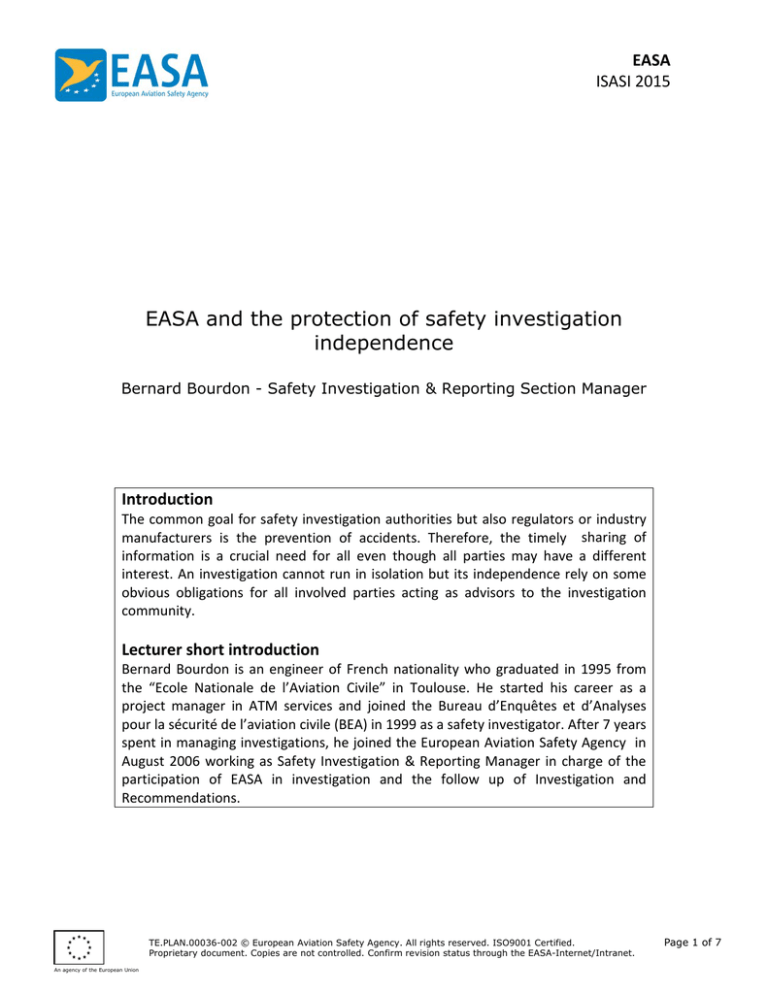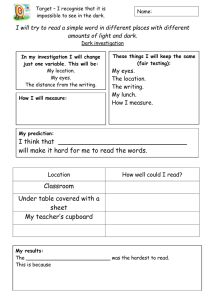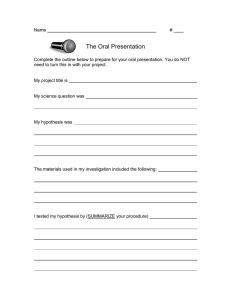
ISASI
EASA
ISASI 2015
EASA and the protection of safety investigation
independence
Bernard Bourdon - Safety Investigation & Reporting Section Manager
Introduction
The common goal for safety investigation authorities but also regulators or industry
manufacturers is the prevention of accidents. Therefore, the timely sharing of
information is a crucial need for all even though all parties may have a different
interest. An investigation cannot run in isolation but its independence rely on some
obvious obligations for all involved parties acting as advisors to the investigation
community.
Lecturer short introduction
Bernard Bourdon is an engineer of French nationality who graduated in 1995 from
the “Ecole Nationale de l’Aviation Civile” in Toulouse. He started his career as a
project manager in ATM services and joined the Bureau d’Enquêtes et d’Analyses
pour la sécurité de l’aviation civile (BEA) in 1999 as a safety investigator. After 7 years
spent in managing investigations, he joined the European Aviation Safety Agency in
August 2006 working as Safety Investigation & Reporting Manager in charge of the
participation of EASA in investigation and the follow up of Investigation and
Recommendations.
TE.PLAN.00036-002 © European Aviation Safety Agency. All rights reserved. ISO9001 Certified.
Proprietary document. Copies are not controlled. Confirm revision status through the EASA-Internet/Intranet.
An agency of the European Union
Page 1 of 7
ISASI
EASA
ISASI 2015
EASA and the protection of safety investigation
independence
1. Background
Established in 2002, EASA enjoys over 10 years in operation. EASA is the European
Union Authority in aviation safety. The main activities of the organisation include the
strategy and safety management, the certification of aviation products and the
oversight of approved organisations and EU Member States.
2. The participation of EASA into Safety Investigation
ICAO Annex 13 recognizes that design-related information shall be made available to the
certifying authority for it to take appropriate safety actions. In the EU, the European
legislator has through Regulation (EC) No 216/2008 entrusted EASA with the
responsibility to carry out the tasks and functions of the State of Design.
Therefore the Regulation (EU) No 996/2010 of the European and of the Council of 20
October 2010 on the investigation and prevention of accidents and incidents in civil
aviation was established to strengthen the independence of the national Safety
Investigation Authorities (SIA) but also to recognise the role of EASA and enable its
participation into Safety Investigation to advise directly the EU Investigator-In-Charge
and/or the EU Accredited Representative outside EU.
Beyond the well-established regulatory framework and recognized ICAO standards,
implementation shows that coordinated communication is also of the upmost
important. Running a successful investigation is not only conditional to a thorough
analysis substantiated with well documented facts, the lessons learned from safety
investigations will not bring additional safety if they are not properly communicated and
accepted by the people in charge of implementing corrective measures.
For every participant in a Safety investigation, the question is also how well the safety
communication is organised? Is the message consistently passed to all interested
parties? Do we target all entities who can learn from our investigations and are able to
take corrective measures? Is a safety message enough or do we need to also do more to
maintain the trust in the aviation system?
1. The need to maintain a real-time communication during a Safety Investigation
TE.PLAN.00036-002 © European Aviation Safety Agency. All rights reserved. ISO9001 Certified.
Proprietary document. Copies are not controlled. Confirm revision status through the EASA-Internet/Intranet.
An agency of the European Union
Page 2 of 7
ISASI
EASA
ISASI 2015
A quick view on the recent accidents show that information is quickly available and that
prompt reactions are expected. Failure to do so leaves room for speculation or at least
can give the feeling that a catastrophic event is not adequately managed and that the
high level of safety is not maintained. It is all the more true since big amount of
casualties are not acceptable.
The timeframe for implementing safety actions after an accident depends on the level of
information available, the priority and the programming based on resources.
For instance, the Air Transat A330 C-GITS Lajes (Azores) on 24 August 2001 experienced
a fuel leak that resulted in dual engine flame out while the aircraft was at 13,000 feet
and 8 miles from an airport. The crew managed to successfully achieve an engines-out
visual approach and landing. As a precautionary transport Canada suspended operator’s
extended Range Twin Operations (ETOPS). Quickly a one-time visual inspection between
the fuel and hydraulic lines on all A330 that caused the leak was communicated by both
the engine and aircraft manufacturers and mandated by Airworthiness Directive.
However, the final end of actions linked to this event ended up 11 years later with the
publication on 6 July 2012 of new Certification Specifications CS-25 aiming at providing
as early as possible, alerts and information to the flight crew to assist them in the task of
managing the fuel quantity on board and managing fuel system condition(s) that, if not
corrected, present a risk of engine fuel starvation. This rule change was consolidating a
systemic issue identified and already covered by other previous safety actions.
Such timeframe might not give the feeling that timely measures are taken by the
competent authority, even though mitigation measures have taken place before. This is
why it is important to promote early measures and use the dynamic of an on-going
investigation.
When the Transasia ATR-72-212A, registration B-22816 crashed shortly after take-off
from Taipei Songshan on 4th February 2015. The Taiwan's ASC reported already on Feb
7th 2015 the descriptive facts including the FDR data plots and key elements extracted
from the transcript showing the feathering of the right hand engine followed by the left
hand engine throttled back.
The information might also come directly from the witness and passengers involved,
benefiting from the wide use of mobile devices and social networks.
With such a tempo, a quick reactive safety is expected. While the causes of the accident
are still under investigation, questions from other Civil Aviation Authorities have to be
dealt and publications related to the management of similar situation by the
manufacturer enable to reassure concerned operators that the situation is under
TE.PLAN.00036-002 © European Aviation Safety Agency. All rights reserved. ISO9001 Certified.
Proprietary document. Copies are not controlled. Confirm revision status through the EASA-Internet/Intranet.
An agency of the European Union
Page 3 of 7
ISASI
EASA
ISASI 2015
control and provide them guidance on what they have to look at. Competent Authority
have to either give assurance that the risk is managed or develop new risks controls.
Many parties might also bring their own piece information. It appears essential that the
divulgation of information is coordinated and that the Safety Investigation Authority
keeps the control of the communication because it has no conflict of interest and offers
the required objectivity.
After the crash of the Germanwings A320 flight 4U9525 in France on March 24th 2015,
the trajectory was quickly available on http://www.flightradar24.com/ and the BEA
made a press release on 25th to explain the trajectory consistent with a selected altitude
set to the minimum.
A competition might take place on how give the information first. The CVR was read on
March 25th evening and the New York Times was already able to report on the content
of the CVR on the 26th in the morning while referring to a declaration of a French
military official involved in the investigation. Based on CVR read out, the States Attorney
of Marseille (France) made a press release on Mar 26th 2015, mentioning that the first
officer was left alone in the cockpit and initiated a rapid descent not responding to air
traffic control and maintaining the cockpit door most likely intentionally closed.
Having all background information, a first short term response is possible. The Agency
published on March 27, 2015 a temporary recommendation for airlines to ensure that
at least two crew, including at least one qualified pilot, are in the flight crew
compartment at all times of the flight. Airlines should re-assess the safety and security
risks associated with a flight crew leaving the cockpit due to operational or physiological
needs. This early publication was made meaningful due to the communication that had
already introduce the subject and received wide acceptance.
Following the issuance of the preliminary report on 6 Novembre, EASA launched a task
force to follow-up and proactively develop mitigation means based on the hearing of
key experts and present conclusions on 1st July 2015.
As facts and events description is quickly available, questions come early in the process
and requires an early involvement in the investigation of stakeholders having
responsibilities in the domain. The role is of course to support the investigation
authority in the determination of the causes of the accident but also to be able to
consider the findings, review the status of risks controls in place and see if additional
controls can be developed.
2. Some principles for a successful participation in a Safety Investigation
TE.PLAN.00036-002 © European Aviation Safety Agency. All rights reserved. ISO9001 Certified.
Proprietary document. Copies are not controlled. Confirm revision status through the EASA-Internet/Intranet.
An agency of the European Union
Page 4 of 7
ISASI
EASA
ISASI 2015
After 6 years of experience with Regulation (EU) No 996/2010, State practice shows that
the involvement of advisors is well managed. This recognises that the roles and
responsibilities are clearly defined and that the involved bodies are ready to cope with a
crisis situation.
The protection of information is essential for maintaining a good information exchange
and applicable EU provisions defines the records that cannot be disclosed.
EASA is working further on the introduction of Document Rights Management measures
to ensure strict compliance with legal obligations and prevent any leakage.
While the system is robust, a lack of communication can however jeopardise the impact
of an investigation process. The diversity of experts, political influence and media
interested in the subject of air accident can also lead to wrong perception and
misrepresentation. Technical advisors have strong expectations that a technical
investigation keeps a strong leadership, make good communication and introduce the
development of safety measures by involved parties.
This is paramount to the success and require adherence to few principles:
• Protection of the confidentiality of the investigation by involved parties to foster
cooperation and information exchange.
• Notifications by all involved parties of intended line of actions to the investigator
in charge to help the coordination. Actions taken by parties participating in the
investigation should remain in coherence with the facts communicated.
The worst case scenario is when the investigation authority miss essential information.
The AF447 mixed altogether grieving of 228 victims’ relatives, cultural differences
impacting 32 different nationalities, 23-month of search during which conflicting
scenarios, speculation and loss of confidence had time to build up despite the
communication strategy developed by the Safety Investigation Authority. The MH370 is
another challenge and the forum is unfortunately still open.
Last but not least, pressure to react promptly must not lead to negative safety. The
consultation process is very important in the validation and acceptance of proposed
measures.
3. Concept of independence versus isolation – a civil aviation authority perspective
The term "independence" is used in several provisions of the EU Regulation, especially
in conjunction with functional independence and the absence of external interference
and conflict of interest. The independence is closely linked to the freedom to act, have
TE.PLAN.00036-002 © European Aviation Safety Agency. All rights reserved. ISO9001 Certified.
Proprietary document. Copies are not controlled. Confirm revision status through the EASA-Internet/Intranet.
An agency of the European Union
Page 5 of 7
ISASI
EASA
ISASI 2015
unrestricted access to all evidences and freedom to publish information. A SIA shall be
shielded from external control that might have different interests.
To solve issues between Member States Safety Investigation authorities in their
relationship with judicial authorities, the requirement of advanced arrangements was
brought in to clarify the respective roles. This advance arrangements properly
recognizes that the investigation is never isolated from the need for justice.
EU Regulation states that Accredited representatives for the State of Design shall be
appointed by the safety investigation authority of the Member State in the territory of
which the principal place of business of the manufacturer is located. This is in practice
established on the basis of the EU products list published on the EASA website, together
with the Type Certificate holder address.
This provision defines the task distribution for EU products. As competent authority, the
Agency rely on a good cooperation with EU Safety Investigation Authorities to properly
balance limited resources with managed workload. This cooperation enables to cope
with worldwide activities.
Reporting related to on-going investigation is often twofold, primarily coming from the
safety investigation authorities involved, it also comes from the holder of a typecertificate issued under the applicable rules on initial airworthiness, and which has
resulted in or may result in an unsafe condition. Strict 72 hours delay applies for
reporting potentially unsafe conditions and the competent certification authority has to
issue mandatory or non-mandatory Continued Airworthiness Information whenever
safety measures are required.
Therefore, An investigation cannot run in isolation. Involved parties have to exchange
information within their remits even though they may follow different interests.
An investigation cannot run in isolation. When safety actions are needed, background
information are usually required and needs to be reported with the Safety Investigation
Authority in charge. It then become a joint responsibility for all involved parties to give a
coherent response to the public and professional, demonstrating that the risk is
controlled or that the system is able to react. The release of Safety Information Bulletin
or issuance by the manufacturers of information bulletins addressed to air operators has
to be coordinated to be understood and reach its goal.
The sole objective is to set up corrective actions while having in mind the importance to
be reactive, the EASA total system approach offers a wide scope of domain. It can then
directly review information stemming from Safety Investigation Authorities and scan
quickly multiple possibilities, thus speeding up the process. It offers also a central relay
TE.PLAN.00036-002 © European Aviation Safety Agency. All rights reserved. ISO9001 Certified.
Proprietary document. Copies are not controlled. Confirm revision status through the EASA-Internet/Intranet.
An agency of the European Union
Page 6 of 7
ISASI
EASA
ISASI 2015
of information towards the 32 EASA Member States and this rich inter-disciplinary
expertise promote the development of quick risk controls as seen previously.
Last, the development of Safety Management System provides more autonomy for
providing a quick response to identified risks. This development takes place at the
organisation level but also rely on cooperation with National Aviation Authorities. The
quick dissemination of identified safety risks enable the development of local safety
controls with shorter deadlines than regulatory activities.
This emphasis on safety risk management is faster than heavy rulemaking activities. In
addition the evolution towards the development of performance based rules also
contribute to offer more flexibility, promote local implementation and speeds up the
process.
4. Conclusion
Modern investigations have to face media speculation, misrepresentation of
information and leaks. It is essential to protect such information and maintain a good
coordinated communication with the leading investigation authority which keep the
sole privilege to determine and publish the causes of an event. This is paramount to the
independence of the investigation.
However, aside the investigation process which needs to thoroughly collect evidences
and take time, there is a need to communicate after the accident on the safety
measures that are taken. Even when the causes are unknown, safety management
systems and safety information dissemination enables to mitigate risks under
investigation with much faster reaction time than traditional rulemaking activity.
Therefore, the Agency has developed internal coordination process aiming at
encouraging the development of fast safety measures in liaison with the investigation
side. As communication is a key component, the Safety Investigation Authority in charge
is the key entity able to coordinate and ensure a coherent response. His communication
is also crucial to the acceptability and implementation of such measures.
TE.PLAN.00036-002 © European Aviation Safety Agency. All rights reserved. ISO9001 Certified.
Proprietary document. Copies are not controlled. Confirm revision status through the EASA-Internet/Intranet.
An agency of the European Union
Page 7 of 7



